VVAM Newsletter 96 – 2004
From the editors
The 60th commemoration of the Battle of Arnhem is now receding into history. They were memorable days which we shall look back on in this Newsletter via photos – all in colour for this issue – and articles. A great many new books about the fighting in the Netherlands in September 1944 have appeared recently, both here and abroad. These publications will be reviewed in this and subsequent Newsletters.
In Memoriam: HRH Prince Bernhard
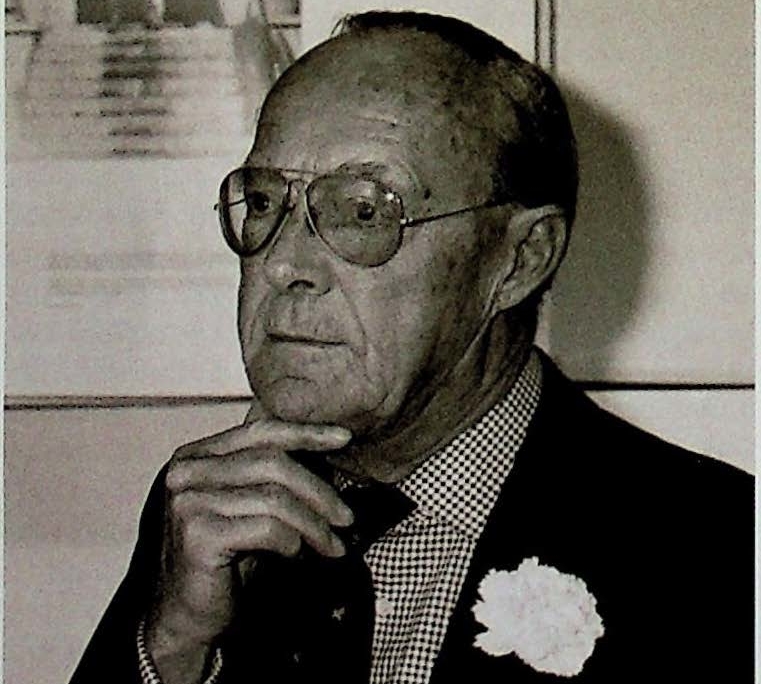
HRH Prince Bernhard, who passed away on 1 December last, visited the Airborne Museum on 11 May 1988 on the occasion of its 10th year in Huize Hartenstein.
On 1 December 2004, HRH Prince Bernhard of the Netherlands passed away. In his capacity as commander of the Forces of the Interior, the prince was closely involved in, among other things, the military operations between September 1944 and May 1945 that led to the liberation of the Netherlands. After the war he attended the commemorations of the Battle of Arnhem on a number of occasions, such as in 1947 and 1969. He visited the Airborne Museum on 21 June 1980 and again on 11 May 1988 for the 10th anniversary of the museum’s opening in Huize Hartenstein.
objects from the Battle of Arnhem, probably saved by my father-in-law, the late Evert Jan Breman, after the bodies of the dead who lay buried in his garden had been exhumed and removed to the Airborne Cemetery. Among them was an item that attracted my attention because it was unlike any of the other pieces of equipment. It consisted of two pieces of weathered roof-tile batten tied together with a length of brown telephone cord. At first I considered throwing this trifling thing onto the fire, but the fact that someone had so carefully tied two pieces of wood together intrigued me. Suddenly, I realized that if you turned the two small battens through a quarter of a turn they formed a cross. Outside, in the daylight, I could just make out a name written in pencil on the cross: Gnr. Baisden.
These, at first sight, worthless pieces of wood immediately took on the significance of a crucifix for me, and I decided to pass it on to the Airborne Museum.
But my curiosity was aroused and over the next few years I learned a fair bit about this gunner from the 1st Airlanding Light Regiment Royal Artillery. Alas, I knew nothing of his family.
During the 60th commemoration someone rang our doorbell. It turned out to be a group of four English people, who introduced themselves as a nephew of Gunner Baisden, his wife, and a granddaughter with her son. At last we had made contact with the family!
A few weeks later I received the following, moving letter:
Dear Mr Roekel,
I am Michelle-Marie, the granddaughter of gunner Alexander Baisden.
Thank you very much for inviting myself and my family into your home and showing us around.
On behalf of my family I wish to express our deepest gratitude towards Mr. Evert Jan Breman and his family for their courage all those years ago.
This was my first visit to Holland, and I hope not my lastl Sadly I wish I could have taken my trip years ago and maybe got to meet some of my grandfather’s fellow soldiersl
What an honour that would have been?
Thank you once again from
Michelle-Marie.
While such letters continue to arrive in Oosterbeek, two generations on nota bene, there can be absolute¬ly no question of abandoning the commemorations of the Battle of Arnhem.
(Chris van Roekel)
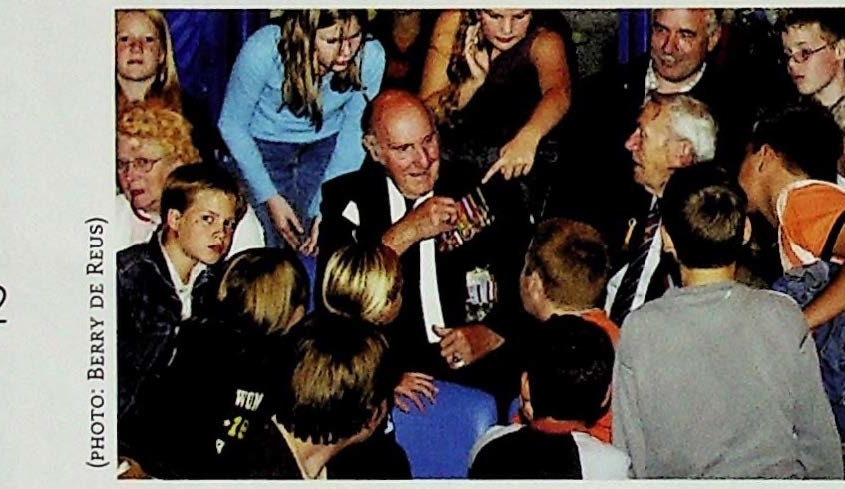
Children admire a veteran’s medals during the commem oration get-together in the Gelredome on 16 September 2004.
Wybo Boersma continuing as provisional director
The previous Newsletter contained an article about the new deputy director of the Airborne Museum, Mr Frans Smolders. The article also announced that Mr Wybo Boersma would be relinquishing the post of director as of 1 October 2004. In view of a number of changed ideas, the situation itself has altered slightly. We have received the following notification from Mr Andre de Vries, chairman of the Airborne Museum Foundation, concerning the make-up and responsibilities of the Airborne Museum director¬ship. The content is as follows:
‘During the last board meeting on 14 October 2004, the Board of the Airborne Museum Foundation dis¬cussed and confirmed the job descriptions of the directors of the museum. For the in-house employ¬ees and volunteers and for the many outside con¬tacts, it has to be clear who in the museum is responsible and contactable, and for what.
The division of tasks within the directorship is pro¬visional for two years and will be revised when the future plans for the museum have been completed and a long term policy has been developed. The out¬lines of the task division are as follows:
Director: Wybo Boersma.
The director reports to the Board of the Airborne Museum Foundation and has the general manage¬ment of the museum. The director is responsible for the PR policy and outside contacts. The director rep¬resents the museum at the meetings of the Society of Friends of the Airborne Museum, the municipal council and joint projects with other museums. The director maintains contact with tour operators and arranges contracts.
The director is responsible for the volunteers’ poli¬cy, the appointment of volunteers, and the appoint¬ment and training of guides.
Deputy director/curator: Frans Smolders.
The deputy director sees to the daily running of the museum, the staff and volunteers, and is responsi¬ble for these to the director. The deputy director is tasked with producing a future plan for the muse¬um. The deputy director is responsible for the daily management of the exhibits as well as for the good working practices of the staff and volunteers, giving directions to that effect. The deputy director main¬tains contacts with the media in conjunction/con- sultation with the director’.
Social Evenings
As in 2004, two ‘Social Evenings’ are to be held early next year in the Airborne Museum. As usual on these occasions, the ‘socialites’ will have the opportunity of taking a look behind the scenes. The first is planned for the evening of 11 February 2005, with part of the evening being given over to the most recent museum acquisitions.
The second Social Evening is scheduled for Monday 14 March 2005, when Professor H. Sosabowski, great-grandson of Major General Stanislaw Sosabowski and lecturer in Brighton, will give a talk on the 1st Polish Independent Parachute Brigade Group and on the role of his great-grand-father during and after the Second world War. The lecture will be in English. Because of the limited room available prior booking is necessary, prefer¬ably per e-mail, info@airbornemuseum.com, or by telephone, 026 3337710. The date 14 march is not yet entirely certain. Any eventual changes will be given on our website www.airbornemuseum.com.
The museum doors will open at 19.30 hours on both evenings, and interested parties will be most welcome in ‘Hartenstein’ from that hour onwards. (W. Boersma)
Arnhem Weekend’ 2005
The Arnhem Weekend’ for our UK members has been fixed for 17, 18 and 19 June 2005. The pro¬gramme will be included in the next Newsletter.
Because of logistical and organisational limitations, the maximum number of participants has been set at 25. 22 Bookings have already been received, so if you still want to come along you will need to con¬tact me as soon as you can.
(Niall Cherry)
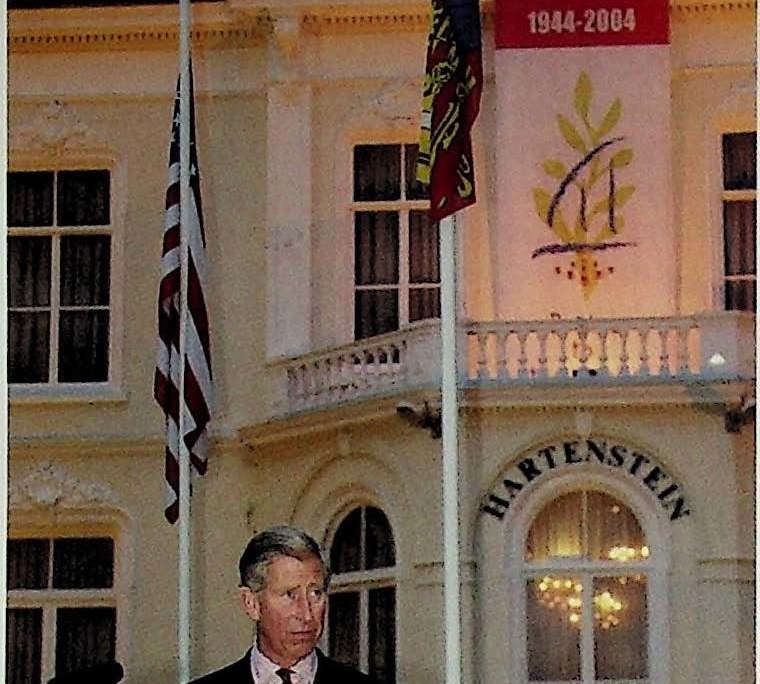
Prince Charles talks to some of the invited guests at the reception in the Airborne Museum on Saturday 18 September 2004.
Film subtitling sponsored
One of the last events of the 60th commemoration of the Battle of Arnhem took place on Sunday evening 19 September 2004 with the open-air show¬ing of the film ‘Theirs is the Glory’. The lawn of the Airborne Monument in Oosterbeek became a film theatre for the evening.
During the preparations for the showing it appeared that no good recording with Dutch sub-titles was available, meaning that much of the spoken word could be missed by the Dutch members of the audi¬ence. Society member Cees van den Bosch found this a great shame and began an action to collect money to enable the production of a Dutch sub¬titled version. Video Studio Bal from Oosterbeek offered to do the technical work at cost price, and the Society of Friends of the Airborne Museum made a considerable contribution. The rest was donated by society members Cees van den Bosch, Robert Voskuil, Geert Maassen, Eugene Wijnhoud and Erik van der Meiden. Robert Voskuil and Joop Bal took care of the translation.
Immediately after the showing requests were received as to the possibility of producing this ver¬sion of ‘Theirs is the Glory’ on DVD.
The possibilities of this are being looked into at the moment. We shall keep you informed!
‘Nine Days at Arnhem’
There is still a lot to be told about the Battle of Arnhem, as shown by the appearance of another new book, ‘Nine Days at Arnhem’, the second book about the 7th Battalion The King’s Own Scottish Borderers by Robert Sigmond. In it the author high¬lights the experiences of the ten CANLOAN officers who served with the battalion. The book is in English, as was Sigmond’s first publication.
The CANLOAN scheme was the name given to the loan – on a voluntary basis – of hundreds of Canadian junior officers to the British army during World War II. They remained in service with the Canadian army but were commanded by British officers, with their deployment being restricted to Europe and the Middle East. In total Canada provid¬ed 673 officers on loan, 102 of whom were killed, 21 died of wounds, 310 were wounded, five have no known grave and Tl POWs were liberated from cap¬tivity. Many of them received decorations. In gener¬al, they were praised by their superiors for their efforts.
Ten of the 90 CANLOAN officers attached to the British airborne troops were allotted to the KOSB battalion. Shortly after the Battle of Arnhem one of the Canadians, Lieutenant Erskine Carter, wrote a diary called ‘Nine Days at Arnhem’, part of which forms the basis of this, Sigmond’s, book
The book gives brief pen-pictures of some of the CANLOAN officers including Lt. Carter, the author of ‘Nine Day’s at Arnhem’. The history of the King’s Own Scottish Borderers is also described. The 7th (Galloway) Battalion was raised in 1939 as a sister battalion to the 5th Territorial Battalion KOSB. Late in 1943 the 7th was attached to the British airborne as glider infantry, and at the beginning of 1944 it received the red beret and Pegasus emblem. The reader follows the training of the CANLOAN officers in Canada, their sea voyage to Britain, their recep¬tion and training in their allotted units, mainly as platoon commanders. It was remarkable that these officers were much closer to their men than the British.
After a number of cancelled operations, Market Garden begins with ten CANLOAN officers in the KOSB battalion, one of whom as a deputy company commander. The 42 officers and 720 men take to the air in 65 gliders. In the chapter about Arnhem, Carter describes his daily experiences, and his story is interspersed with those of others, the whole giv¬ing a lively account of events. The book describes the task of the battalion, the securing of the drop¬ping and landing zones on 18 and 19 September, the overnight movements, the battles against the Germans, the landing of the Poles on Johannahoeve, the lack of sleep and the hunger. We see the battal¬ion withdraw to Oosterbeek, the fighting around the Dreyeroord hotel and in the ‘South Africa’ district of Oosterbeek. Because of the increasing number of dead and wounded the battalion becomes smaller and smaller. Despite this it still manages to pull off some astounding feats, such as daring two German tanks to come into the open so that an anti-tankgun can get a better shot, and bayonet charges. By Monday 25 September the situation has become hopeless, and the remnants of the battalion are withdrawn across the Rhine. The KOSB leaves behind 105 dead and some 580 men are taken pris¬oner, including eight CANLOAN officers. The rest of the men of the battalion are wounded. Five of them die of their wounds within a week. Nine men die in German camps and one officer is killed during Operation Pegasus. We meet the officers again in various POW camps such as
Braunschweig, Spangenburg and Fallingbostel, and read about the death marches of the retreating German army.
After its return to England the battalion is re¬formed with the addition of many new recruits and junior officers. On 9 May 1945 the unit and its new commander leave for Norway, where it is to help with the repatriation of the German army of occu¬pation and the imprisonment of war criminals. Over the coming months 400,000 German servicemen are disarmed, screened and sent home. By August 1945 the task is complete and the battalion returns home. At the end of November the 7th Battalion KOSB is disbanded. The book closes with numerous information appendices.
The book has been thoroughly researched, which makes it a pleasant read for the knowledgeable. The personal accounts paint a lively picture of events, to the extent that readers almost feel they were there themselves. As we have come to expect from R.N. Sigmond Publishing, the book is beautifully pro¬duced, contains many illustrations and good maps, and, as already mentioned, reads easily. The 180 page book costs € 32,50 (ISBN 90-804718-7-9).
(Okko Luursema)
Border Regiment plaque unveiled
On 17 September 2004 a large plaque was unveiled on the east wall of the Westerbouwing restaurant in Oosterbeek. The plaque is dedicated to the 800 offi¬cers and men of the 1st Battalion The Border Regiment who fought at Arnhem between 17 and 26 September 1944. During the battle this battalion defended the western edge of the ‘Perimeter’, from Sonnenberg up to the Westerbouwing. The Wester¬bouwing heights upon which the restaurant stands were defended by B Company. On 21 September 1944 this area became the scene of heavy fighting when strong German units, supported by tanks, opened the attack. This historic place is therefore the perfect location for the plaque which remem¬bers a battalion that suffered heavy casualties. 125 Men were killed and 400 were taken prisoner, many of them wounded.
The unveiling was attended by many people, includ¬ing a group of Border Regiment veterans.
25th Anniversary and other important dates
A jubilee committee of Friends’ Society board members are busily engaged with the organisation of the 25 year jubilee. Programme details will be included in the first Newsletter of the New Year. But make sure you keep 21 May 2005 open!
Other activities and dates that you can make a note of are: the AGM on 2 April 2005, the Book Fair on 23 April, and the Normandy Excursion from 25-31
Historic unveiling at commemoration in Brummen
On Saturday afternoon 18 September last a dramatic commemoration took place in front of the Old Post Office in Brummen, recalling a drama that occurred there sixty years ago.
On 23 September 1944 a German SS soldier opened fire with a Schmeisser machine gun on a passing lorry containing 25 British parachutists, who had landed six days earlier near Arnhem.
A true bloodbath ensued, leaving six dead and many wounded. A war crime plain and simple, because it was a group of helpless prisoners of war that was fired on.
The details of this drama were only made public ten years ago – with the opening of archives in London – and a monument was raised at the site. Being the sixtieth anniversary of the Battle of Arnhem, this year’s commemoration had a special tint. There were extensive daily reports on television about Arnhem and Oosterbeek, but Brummen did things its own way, partly in the street – the roads were closed for two hours – and partly in the old building, nowadays the Old Post Office hotel. Of course there was an emotional placing of wreaths, besides which
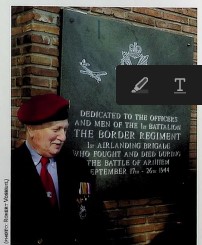
17 september 2004, a large plaque was unveiled on the east wall of the Westerbouwing restaurant.
The four people made short speeches, one speaker revealing unique details of a resistance plan from September 1944.
The now 87 year-old ex-resistance fighter Gerard Schut recalled how the then head of the Resistance, Baron Loet van der Feltz, brought him into contact with Major Tony Hibbert, who had escaped near the post office (Major Hibbert, also 87, was present at the commemoration). A few days after the air land¬ings the two men met up at the baron’s home in Eerbeek, together with Grote Gijs (Piet Kruijff), head of the Arnhem Resistance, and a few of his com¬rades. Tony Hibbert talked about the hopeless bat¬tles that were still raging in Arnhem/Oosterbeek. He came up with a plan to give Arnhem ‘breathing space’ by carrying out a new airborne landing between Eerbeek and the Gelderland capital! This has never been mentioned in any of the dozens of history books about Arnhem’. At least, it can now be added, even as just a footnote, to the equally glori¬ous, as sad, history.
How did it end up? Gerard Schut talking in the Old Post Office: ‘Up till then we had had a peaceful exis¬tence, apart from regularly finding a hiding place at Coldenhove or wherever for downed airmen. Then, on 17 September 1944 we received a joyous phone call from Oosterbeek telling us of the British air¬borne landings. We are free! Alas, it didn’t last long although we couldn’t have known that at the time. But we did know that the airborne were beginning to have a tough time in Arnhem and Oosterbeek. An attack at the German rear could bring some relief to the men battling in Arnhem. I don’t remember how many parachutists we had in mind; nothing was ever written down. Maybe a battalion of 500 men or so. We Resistance men knew of suitable places for a landing, such as Imbos and Rozendaal Heath. Ordnance survey maps were fetched. A lovely plan, the Brummen and Arnhem Resistance would pro¬vide support. Personally I didn’t see much in it. After thorough staff meetings at my house not much more came of it. Logical. Tony Hibbert might have been a great strategist, but meanwhile the fighting in Arnhem and Oosterbeek had come to an end. There was now no point in a new airborne operation’.
The main person at the Brummen commemoration was of course Tony Hibbert, who fought together with Colonel Frost for four days at the bridge in Amhem in September 1944. He was one of the POWs who jumped from the lorry in Brummen. It is still a source of great sorrow to him that his (totally justified) escape attempt cost the lives of six of his comrades. He expressed the hope that this com¬memoration would last forever, and that in 100 years time, our great-grandchildren would still know of it. He thanked the courageous and brave people of Brummen who provided British escapees with secret hiding places, medical help and food in September 1944. He then placed the first wreath at the plaque on the wall of the Old Post Office, fol¬lowed by the burgomaster and a number of citizens. There was also a moving speech by Henk Peters who, as a 17 year-old, remembered an exhausted, wounded British soldier knocking on the door of his parent’s farmhouse in Knoevenoorstraat, saying: I am a British soldier, I am Tony Hibbert”. He was warm¬ly welcomed inside and fed, and then spent three days in a chicken coop. Meanwhile, Henk tipped off the Brummen Resistance, after which the officer laid low for three weeks in a secret hideout at the home of the Tjeenk Willink family in Burgemeester De Wijslaan. In that time the ever-active Hibbert outlined plans in conjunction with the resistance in Eerbeek that would lead to the great escape opera¬tion across the Rhine, Operation Pegasus I, in October 1944.
(Piet Willemsens)
Photo: location of British patrol
In Newsletter No. 94 of June 2004, we asked readers if anyone could identify where the widely-known photo of a 4-man British patrol ‘somewhere in a building in Oosterbeek’ was taken. We said then that the photo was taken by Sergeant Lewis of the Army Film and Photographic Unit, and refers to frame 7 (not 8 as mentioned in error) from film 4. All the pictures on this film were shot near the Hartenstein.
Various members have responded to our appeal and here is a short survey: Mr J. Visser in Zelhem writes that the man in the beret is Staff Sergeant Mark Leaver, G Squadron Glider Pilot Regiment. Mark Leaver, who died on 31 October 2000, said at the time that the photo was taken in ‘Beekweg’. This probably meant the Van Hofwegen laundry in present day Zuiderbeekweg. Mrs Betty de Roder from Renkum suggests it could be the premises of Aits forge in Paul Krugerstraat. Ir. F. Oudendal from Huizen says that the concrete reinforcing bars were probably intend¬ed for some sort of German building work because, by 1944, such material had been unavailable for pri¬vate use for many years. Mr J.C. Bierdrager in Eelde points out that in Stuart Eastwood’s book ‘When Dragons Flew, An Illustrated History of the 1st Battalion the Border Regiment 1939-1945’, the pic¬ture caption says: ‘The location is unknown, but may be the stableblock of the Hartenstein Hotel’.
In our opinion this last possibility is closest to the truth, a conclusion based partly on our own research. Our detective work led to the following result.
It is known that the Germans were building a com¬munications bunker to the east of the present Kleyn Hartensteyn Restaurant, the (former) coach house of Huize Hartenstein. Unfortunately, because of the thick foliage there is not much of this work to be seen in the aerial photos taken on 6 and 12 Septem¬ber 1944 as preparation for the forthcoming air¬borne landings.
Sixty years ago the estate orangery stood to the east of the coach house, where large potted plants were stored in winter. We concentrated our research on this building. On 15 March 1945, No. 4 Reconnais¬sance Squadron RAF flew a reconnaissance mission over the South Veluwe, It must have been an excep¬tionally clear, sunny day because most of the aerial photos taken that day are razor sharp. The series of
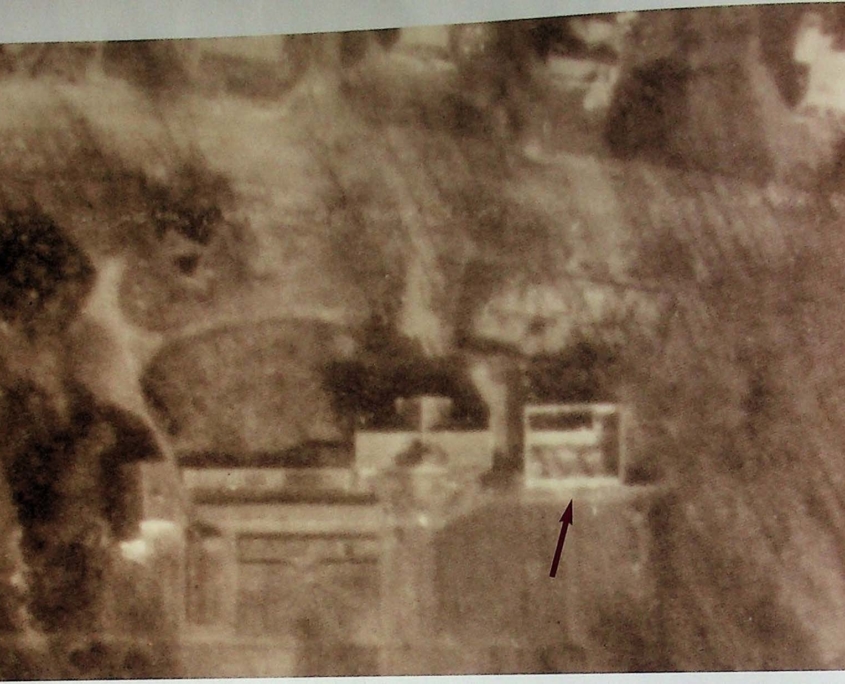
Detail from an RAF aerial photograph taken on 15 March 1945. In the centre is the coach house, now the Kleyn Hartensteyn restaurant. Left are the greenhouses, long since demolished, and far left is the gardener’s house. Right of the coach house is the orangery, minus roof. Utrechtseweg can be seen at the top of the photo, with a couple of villas and the turn off to Steijnweg just visible. This photo detail is not as sharp as it could be because of the high magnification. On the original photo the ‘cut-out’ detail measures just 18 x 15 mm!
photos on which the Hartenstein estate appears were viewed under a mirror stereoscope using an extremely high magnification. The analysis of the orangery building revealed various interesting details, which led us to the conclusion that this was where the photo of the patrol was taken. A greatly enlarged detail from the aerial photographs is used to illustrate this article.
The aerial photo shows that the building no longer had a roof at the time, so you seem to be looking at a floor plan of the building. It can be assumed that the roof was of light construction using a lot of glass, common in buildings used for over-wintering plants. This construction could have been damaged, or collapsed, during or after the battle. Sergeant Lewis’s photo shows that the wall in the background turns a corner so that the right hand part of the wall is further back than the left. This feature is clearly shown in the aerial photo of the orangery. Behind the wall top left was a separate room, walled off from the large L-shaped main room. From the stereo image and analysis of the shadows it can be seen that there was probably a wide door in the south wall of the main room with large windows or doors on each side. Lewis stood outside, camera pointed at the door opening in the centre, and the patrol moved from inside the room towards him. Un-doubtedly this was a posed scene.
The concrete reinforcing and pipes stored in the orangery were almost certainly intended for use in the building of the German bunker mentioned above.
After the war the badly damaged orangery was demolished. Today, the spot next to the Kleyn Hartensteyn restaurant has been given over to greenery and a car park.
Alas, up to now we have been unable to find any pic¬tures of the orangery. If any of you could help us here we would be most grateful. Information about the building would also be very welcome!
(Robert Voskuil)
The floor of De Tofelberg
As many of you are aware, very little remains of that once-stately building, Huize De Tafelberg in Oosterbeek, just the front elevation and a small sec¬tion of the west elevation. During the Battle of Arnhem De Tafelberg was used as a hospital, which changed hands between the British and Germans on several occasions. Many heart-rending scenes were played out here, where British medical person¬nel, Dutch doctors and volunteers struggled hard to save human lives. The Society of Friends, and oth¬ers, offered to conserve and maintain the building, but – partly due to the poor structural state of the building — this was considered unfeasible. Discussions and negotiations between Renkum council and the property developers, in which the society was involved, led to the retention of the front elevation and sections of the floor, as well as the striking and recognisable staircase and wain¬scoting.
As the story has it, here and there the hall floor of De Tafelberg bears the stains of blood shed by British soldiers, visible as hazy, light-brown spots. On September 1 2004, representing the friends, I indicated two places on the floor which were then cut out by one of the property developers’ employ¬ees, using a concrete cutting disk. One of the floor segments was given to the Airborne Museum, while the other section will eventually be displayed in the hall of the apartment block when the building is complete.
We presume that the staircase and part of the wain¬scoting will also be put back in place in the ‘reno¬vated’Tafelberg. These items appear prominently in the film ‘Theirs is the Glory’, made in 1945.
(Ivar Goedings)
Obituary: Commando Knottenbelt
On 19 August 2004, Maarten Jan Knottenbelt passed away in Den Haag. He was 83. In September 1944, Lieutenant Knottenbelt was one of the ten Dutch commandos who took part in the Battle of Arnhem. One of his tasks was to coordinate the deployment of the resistance groups present in and around Arnhem. In the afternoon of 17 September he was with the unit which ambushed the Feldkommandant of Arnhem, Generalmajor Kussin, at the corner of Wolfhezerweg/Utrechtseweg. During the battle, and on his own initiative, he took command of a unit of British soldiers which was defending a key position in a group of houses in Oosterbeek. When the Poles landed at Driel on 21 September 1944, he crossed the Rhine to the south bank in order to establish contact with them. Later on he brought Polish sol-diers back across the Rhine and took them to British positions in Oosterbeek. He did this repeatedly. He was wounded on 22 September but refused to be taken to any of the emergency hospitals. When the withdrawal took place on the night of 25/26 September 1944 he managed to swim across the Rhine to safety. On arrival in Nijmegen he was at last able to have his wounds treated.
Monument to the RAF
On Monday 13 September 2004 a new monument was erected in Doorwerth to commemorate the role played by the Royal Air Force during the Battle of Arnhem. In that period 229 airmen and air despatchers lost their lives.
The monument is in the form of a pillar wit plaque, and stands at the Rehoboth School in Bentincklaan. A British Stirling of 196 Squadron RAF crashed at this site on 21 September 1944 dunng a re-supply flight to the British isolated in Ooster¬beek. All crew members and air despatchers died in the crash.
The memorial was the brainchild of Philip Reinders and, thanks to private donations and the co-operation of the school governors, the dream is now reality.
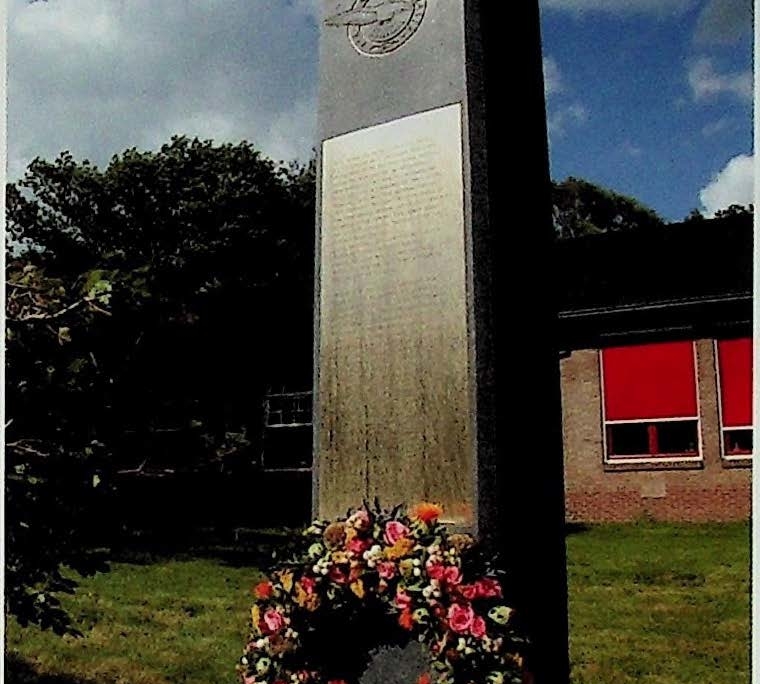
The new monument to the Royal Air Force at Bentincklaan in Dooruierth, which was raised on 13 September 2004 to commemorate RAF operations during the Battle of Arnhem.
The press and the Battle
Early in September this year I felt compelled to compose the following letter and send it to De Gelderlander (regional newspaper). On the 13th of the month it was published in the paper under the heading ‘Fabeltjeshrant’ (a children’s TV programme of fairy stories).
‘The Airborne commemoration time approaches and once again the fantasists and fibbers crawl out of the woodwork to spout their nonsense about the Battle of Arnhem. And sadly, the newspaper falls for it, printing a profuse account of the experiences of so-called veterans and historical researchers. Therefore, last Monday (6 September 2004) we were treated to an article in De Gelderlander about an eld¬erly Belgian who distinctly remembers landing by parachute at Wolfheze on 17 September 1944. Not only that: he was accompanied by, n.b., 60 of his countrymen. They were all members of the SAS (Special Air Service), a British army special-forces unit. 59 Belgians died in the battle. Said the Fleming (according to the paper).
For goodness sake, what rubbish! Tripe of the first order, and the journalist set it all down in good faith. Over the 60 intervening years Mr Daenens’ mental powers must have deteriorated drastically, and/or he is just a liar. The man did not take part in the Battle of Arnhem and neither did his so-called comrades.
It is not the first time De Gelderlander has been taken for a ride. The paper of Wednesday 21 July 2004 con¬tained a piece about the Poles in Driel, probably lift¬ed from that awful little ‘masterpiece’ ‘Arnhem 1944, Battle of the SETBACK’ by Bert Kerkhoffs. Among the things I read was ‘the blood-drenched landing of the Polish paras near Driel’. A bloodbath? Not really! Of the 1,000 Poles who landed on 21 September, five were killed and 36 were wounded, mostly injured when landing. Kerkhoffs writes about the men of the 1st Polish Independent Parachute Brigade Group who were fired on by the British: ‘because we Poles wore different uniforms and berets.’ Well, what waffle! The Polish uniforms were exactly the same as the British, and, of course, in battle they wore parachutist helmets, not their grey berets. And again, the helmets were just the same as those worn by the soldiers of the 1st British Airborne Division!
At the moment I am looking forward to the coming editions with fear and trepidation. Not so long ago Red Indians popped up, who had allegedly played an important part in the fighting in our region. We have already had Norwegians, and now I expect Eskimos and gnomes to appear at any minute!” With regard to the newspaper articles in question, I have received support from other Friends who also take seriously the writing of the history of the Battle of Arnhem. The Belgian had to admit publicly that he was not in Oosterbeek at that particular time and that the story of his 60 colleagues is nothing but hearsay.
But that’s not all. De Gelderlander 13 September 2004: ‘‘Volunteer Pauline Otten from the Arnhem War Museum (not to be confused with the Airborne Museum in Oosterbeek) in Schaarsbergen, claims that American Indians were attached to the 1st British Airborne Division during the battle.”lndians were used as code-talkers. The Germans could not decode their language”, opines Otten. She even states that there are five Mohawk Indians buried at Moscowa, the Arnhem cemetery. Where? She is unable to say. It is the joke of the day at Moscowa. “We have never come across them, yet!” There are allied soldiers buried at Moscowa, but the majority of these were killed before or after the ‘battle of the setback’.
A number of the newspaper’s subscribers have writ¬ten to me saying that I am really mistaken with regard to both the Indians and the Poles. Of course 1 would be the first to admit that I, too, make mis¬takes, so I intend asking them which sources they have consulted that would prove my claims incor-rect. If there are any Friends who could put me right on this and have something to tell, for example about the deployment of Belgian SAS men or Norwegian soldiers during the Battle of Arnhem, I would be most grateful!
(Geert Maassen)
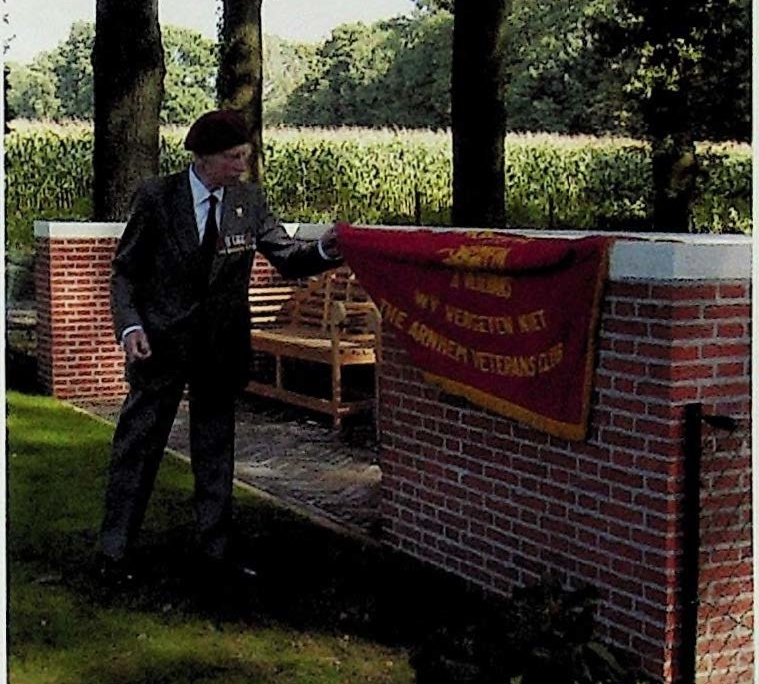
On 17 September 2004 Major General A. Deane- Drummond unveiled a bench at the Airborne Cemetery. The plaque attached to the bench wall states: ‘In lasting gratitude to the people of this neighbourhood for their loving care of the graves of our comrades who lie here and in other cemeteries nearby and to the children who honour them with their flowers. British and Polish Veterans of 1944, September 2004’
COLOPHON
The Newsletter is a publication of the Society of Friends of the Airborne Museum Oosterbeek (SFAM) and appears four times per year. The objective is to promote the Airborne Museum, the SFAM and the history of the Battle of Arnhem.
Editors: drs. R.P.G.A. Voskuil and G.H. Maassen jr. Editorship address: Jan van Riebeeckweg 39, 6861 BD Oosterbeek; e-mail: wam@planet.nl Coordination sending, archiving and distribution of back numbers: Chris van Roekel, Oosterbeek.
English translation: Cathrien and Peter Clark.
Design: Hildebrand DTP, Wageningen.
Print: Drukkerij Verweij Wageningen BV.
SFAM representative in the U.K.: Niall Cherry, 3 Church Road, Warton, Lancs PR4 1BD, tel. 01772 632764; e-mail: niall.cherry@baesystems.com Airborne Museum ‘Hartenstein’ address:
Utrechtseweg 232, 6862 AZ Oosterbeek, telephone 00 31 26 3337710;
e-mail: info@airbornemuseum.com
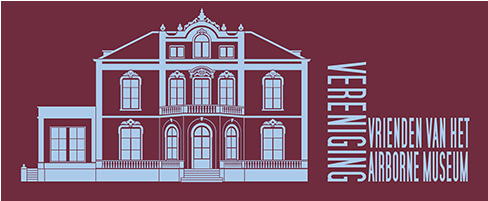
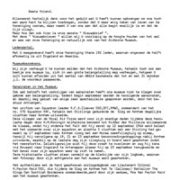
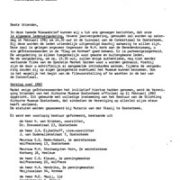
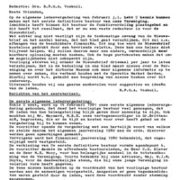
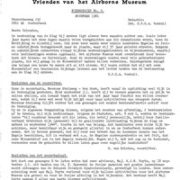
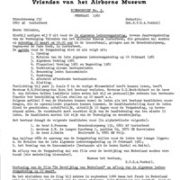
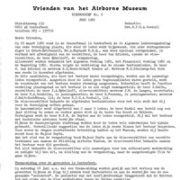
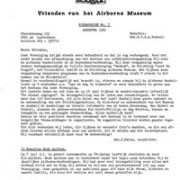
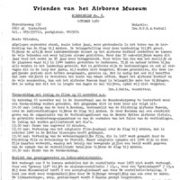
Plaats een Reactie
Vraag of reactie?Laat hier uw reactie achter.